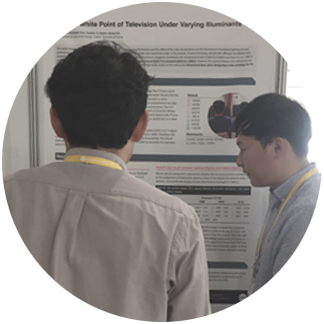Taesu Kim, an undergraduate intern of Color Lab for the last two months presented a poster entitled, “Optimal White Point of Television Under Varying Illuminants” on the AIC 2017 held in Jeju. The study investigated the optimal white point of QLED TV under varying illuminants. In this study, he conducted a visual examination of whiteness of 8 stimuli under 12 varying illuminants to examined the white point of the display under different illuminants’ color temperature. The study expects to be used as the theoretical basis when designing a color strategy for TV display manufacturing or Asian broadcast white point calibration.
Abstract
This study investigates the optimal white point of QLED TV under varying illuminants, and the effect of the color temperature and the illuminance of ambient lighting on user preferences were observed. For a visual examination, a total of 8 nuanced whites were examined under 13 illuminants. A total of 8 display stimuli with different correlated color temperatures (4,000 K ~ 15,000 K) were presented on a QLED TV. The ambient illuminants ranged in correlated color temperature from 3,500 K to 8,000 K and from 0 lx to 1,000 lx in illuminance. Based on assessments by 104 subjects, an optimal color temperature of QLED TV is around 6,000 K to 7,000 K. However, the optimal display color temperatures lower than the default white point of Asian broadcasts. It is expected that the findings of this study can be used as the theoretical basis when designing a color strategy for TV display manufacturing or Asian broadcast white point.


